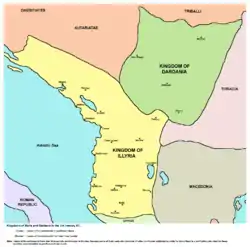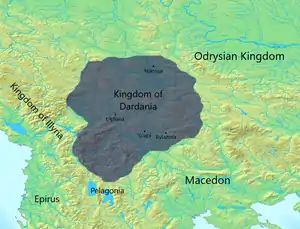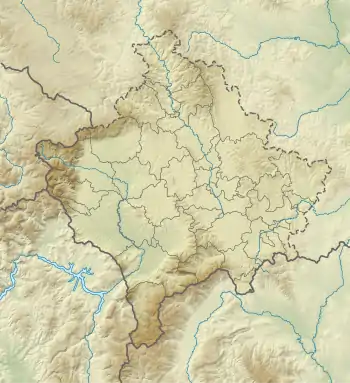Kingdom of Dardania
The Kingdom of Dardania was a polity formed in the central Balkans in the region of Dardania during classical antiquity. It is named after the Dardani, a Paleo-Balkan tribe which formed its population and formed the core of the Dardanian polity. Dardania included present-day Kosovo[a], northwestern North Macedonia, parts of the Sandžak region and area of Naissus in Serbia and the Kukës County in Albania. The eastern parts of Dardania were at the Thraco-Illyrian contact zone.
Kingdom of Dardania | |||||||||
|---|---|---|---|---|---|---|---|---|---|
| 393 BC–28 BC | |||||||||
 Map of Dardanian Kingdom (green) | |||||||||
| Religion | Polytheism | ||||||||
| Government | Monarchy | ||||||||
| King | |||||||||
• 393-358 BC | Bardylis (first) | ||||||||
| Historical era | Classical antiquity | ||||||||
• Founded | 393 BC | ||||||||
• Roman conquest | 28 BC | ||||||||
| Area | |||||||||
| 45,000 km2 (17,000 sq mi) | |||||||||
| |||||||||
| Today part of | Albania Kosovo[lower-alpha 1] North Macedonia | ||||||||
History
Dardania was first mentioned in the 4th century BC, after king Bardylis united Dardani tribes into a single state. He defeated Macedonians and Molossians several times. At this time they were strong enough to rule Macedonia through a puppet king in 392-391 BC. In 385-384 they allied with Dionysius I of Syracuse and defeated the Molossians, killing up to 15,000 of their soldiers and ruling their territory for a short period. Their continuous invasions forced Amyntas III of Macedon to pay them a tribute in 372 BC. They returned raiding the Molossians in 360. In 359 BC Bardylis won a decisive battle against Macedonian king Perdiccas III, whom he killed himself, while 4,000 Macedonian soldiers fell, and the cities of upper Macedonia were occupied. Following this disastrous defeat, king Philip II took control of the Macedonian throne in 358 and reaffirmed the treaty with the Dardani, marrying princess Audata, probably the daughter or niece of Bardylis. The time of this marriage is somewhat disputed while some historians maintain that the marriage happened after the defeat of Bardylis. This gave Philip II valuable time to gather his forces against those Dardani who were still under Bardylis, defeating them at the Erigon Valley by killing about 7,000 of them, eliminating the Dardani menace for some time.[1][2][3][4][5]
In 334 BC, under the leadership of Cleitus, the son of Bardylis, the Dardani, in alliance with other Illyrian tribes attacked Macedonia held by Alexander the Great. The Dardani managed to capture some cities but were eventually defeated by Alexander's forces.[6]
Celts were present in Dardania in 279 BC. The Dardanian king offered to help the Macedonians with 20,000 soldiers against the Celts, but this was refused by Macedonian king Ptolemy Keraunos.[7][8]

Dardani were a constant threat to the Macedonian kingdom. In 230 under Longarus they captured Bylazora from the Paionians and in 229 they again attacked Macedonia, defeating Demetrius II in an important battle. In this period their influence on the region grew and some other Illyrian tribes deserted Teuta, joining the Dardani under Longarus and forcing Teuta to call off her expedition forces in Epirus. When Philip V rose to the Macedonian throne, skirmishing with Dardani began in 220-219 BC and he managed to capture Bylazora from them in 217 BC. Skirmishes continued in 211 and in 209 when a force of Dardani under Aeropus, probably a pretender to the Macedonian throne, captured Lychnidus and looted Macedonia taking 20.000 prisoners and retreating before Philip's forces could reach them.[8]
In 201 BC, Bato of Dardania (along with Pleuratus the Illyrian and Amynander, King of Athamania) cooperated with Roman consul Sulpicius in his expedition against Philip V. Always being under the menace of Dardanian attacks on Macedonia, Philip V made an alliance with the Bastarnae at around 183 BC and invited them to settle in Polog, the region of Dardania closest to Macedonia. A joint campaign of the Bastarnae and Macedonians against the Dardanians was organized, but Philip V died and his son Perseus of Macedon withdrew his forces from the campaign. The Bastarnae crossed the Danube in huge numbers and although they didn't meet the Macedonians, they continued the campaign. Some 30,000 Bastarnae under the command of Clondicus seem to have defeated the Dardani. In 179 BC, the Bastarnae conquered the Dardani, who later in 174 pushed them out, in a war which proved catastrophic, with a few years later, in 170 BC, the Macedonians defeating the Dardani. Macedonia and Illyria became Roman protectorates in 168 BC. The Dardanian Kingdom retained its sovereignty until 28 BC, when the Romans conquered the region (and consequently it).[9][8]
The Romans created the province of Moesia from parts of Dardania, but later made it a separate province.
Geography
Sites
| # | Settlement[note 1] | Description | Location | Geographic coordinates | Ref. |
|---|---|---|---|---|---|
| 1 | Municipium Dardanorum | Soqanicë | 43°3′17″N 20°48′36″E | [10] | |
| 2 | Romajë | Romajë | 42°17′31″N 20°35′34″E | [11] | |
| 3 | Busavatë | Busavatë | 42°34′49″N 21°32′36″E | [12] | |
| 4 | Ulpiana | Ulpiana | 42°35′47″N 21°10′31″E | [13] | |
| 5 | Vindenis | Gllamnik | 42°51′58″N 21°10′59″E | [14] | |
| 6 | Vlashnjë | Vlashnjë | 42°12′09″N 20°39′45″E | ||
| 7 | Topanicë | Topanicë | 42°31′25″N 21°38′23″E | [15] | |
| 8 | Dubovc | Dubovc | 42°46′37″N 20°54′37″E | [16] | |
| 9 | Dardana Fortress | Kamenica | 42°35′33″N 21°33′49″E | [17] |
Culture
The eastern parts of the region were at the Thraco-Illyrian contact zone. In archaeological research, Illyrian names are predominant in western Dardania (present-day Kosovo), while Thracian names are mostly found in eastern Dardania (present-day south-eastern Serbia). Thracian names are absent in western Dardania; some Illyrian names appear in the eastern parts.[18][19] The correspondence of Illyrian names, including those of the ruling elite, in Dardania with those of the southern Illyrians suggests a "thracianization" of parts of Dardania.[20][21] Strabo in his geographica mentions them as one of the three strongest Illyrian peoples, the other two being the Ardiaei and Autariatae.[22]
Rulers
The Kingdom of Dardania was ruled by various kings.
- Bardylis (393-358 BC)
- Cleitus (356-355 BC)
- Bardylis II (295-290 BC)
- Monunius I (290-270 BC)
- Mytilus (270-231 BC)
- Longarus (231-206 BC)
- Bato (206-176 BC)
- Monunius II (176-167 BC)
Notes
- Kosovo is the subject of a territorial dispute between the Republic of Kosovo and the Republic of Serbia. The Republic of Kosovo unilaterally declared independence on 17 February 2008. Serbia continues to claim it as part of its own sovereign territory. The two governments began to normalise relations in 2013, as part of the 2013 Brussels Agreement. Kosovo is currently recognized as an independent state by 98 out of the 193 United Nations member states. In total, 113 UN member states recognized Kosovo at some point, of which 15 later withdrew their recognition.
See also
Notes
| a. | ^ Kosovo is the subject of a territorial dispute between the Republic of Kosovo and the Republic of Serbia. The Republic of Kosovo unilaterally declared independence on 17 February 2008. Serbia continues to claim it as part of its own sovereign territory. The two governments began to normalise relations in 2013, as part of the 2013 Brussels Agreement. Kosovo is currently recognized as an independent state by 98 out of the 193 United Nations member states. In total, 113 UN member states recognized Kosovo at some point, of which 15 later withdrew their recognition. |
- Italics: the ancient names are unattested.
References
- Lewis, D.M.; Boardman, John (1994). The Cambridge Ancient History. Cambridge University Press. pp. 428–429. ISBN 978-0-521-23348-4.
- James R. Ashley (1 January 2004). The Macedonian Empire: The Era of Warfare Under Philip II and Alexander the Great, 359-323 B.C. McFarland. pp. 111–112. ISBN 978-0-7864-1918-0.
- Elizabeth Donnelly Carney (2000). Women and Monarchy in Macedonia. University of Oklahoma Press. p. 274. ISBN 978-0-8061-3212-9.
- James R. Ashley (1 January 2004). The Macedonian Empire: The Era of Warfare Under Philip II and Alexander the Great, 359-323 B.C. McFarland. pp. 111–112. ISBN 978-0-7864-1918-0.
- N.G.L. Hammond (1 August 1998). The Genius of Alexander the Great. University of North Carolina Press. p. 11. ISBN 978-0-8078-4744-2.
- Lewis, D.M.; Boardman, John (1994). The Cambridge Ancient History. Cambridge University Press. pp. 428–429. ISBN 978-0-521-23348-4.
- Robert Malcolm Errington (1990). A History of Macedonia. University of California Press. p. 160. ISBN 978-0-520-06319-8.
- Hammond, N.G.L. (1988). A History of Macedonia: 336-167 B.C. Clarendon Press. p. 253. ISBN 0-19-814815-1.CS1 maint: ref=harv (link)
- A history of Macedonia Volume 5 of Hellenistic culture and society, Author: Robert Malcolm Errington, University of California Press, 1990 ISBN 0-520-06319-8, ISBN 978-0-520-06319-8, p. 185
- Wilkes 1992, p. 258.
- Schermer, Shukriu & Deskaj 2011, p. 236.
- Alaj 2019, p. 41.
- The Roman army as a community: including papers of a conference held at ...by Adrian Keith Goldsworthy, Ian Haynes, Colin E. P. Adams, ISBN 1-887829-34-2, 1997, page 100
- Fjalor enciklopedik shqiptar, Akademia e Shkencave e Shqipërisë, Tiranë, 2009, fq. 2870 – 2871. ISBN 978-99956-10-32-6.
- Alaj 2019, p. 51.
- Alaj 2019, p. 65.
- Alaj 2019, p. 91.
- Papazoglu 1978, p. 131
the Dardanians ... living in the frontiers of the Illyrian and the Thracian worlds retained their individuality and, alone among the peoples of that region, succeeded in maintaining themselves as an ethnic unity even when they were militarily and politically subjected by the Roman arms [...] and when, towards the end of the ancient world, the Balkans were involved in far-reaching ethnic perturbations, the Dardanians, of all the Central Balkan tribes, played the greatest part in the genesis of the new peoples who took the place of the old
- Waldman, Carl; Mason, Catherine (2006). Encyclopedia of European Peoples. Infobase Publishing. p. 205. ISBN 1438129181.
According to ancient sources, the Dardani, variously grouped but probably Illyrians, lived west of present-day Belgrade in present-day Serbia and Montenegro in the third century B.C.E, their homeland in the ancient region of Thrace (and possibly there since the eight century B.C.E).
- Joseph Roisman; Ian Worthington (7 July 2011). A Companion to Ancient Macedonia. John Wiley & Sons. p. 301. ISBN 978-1-4443-5163-7.
- Wilkes 1992, p. 85
Whether the Dardanians were an Illyrian or a Thracian people has been much debated and one view suggests that the area was originally populated with Thracians who then exposed to direct contact with Illyrians over a long period. [..] The meaning of this state of affairs has been variously interpreted, ranging from notions of Thracianization' (in part) of an existing Illyrian population to the precise opposite. In favour of the latter may be the close correspondence of Illyrian names in Dardania with those of the southern 'real' lllyrians to their west, including the names of Dardanian rulers, Longarus, Bato, Monunius and Etuta, and those on later epitaphs, Epicadus, Scerviaedus, Tuta, Times and Cinna.
- Alaj 2019, p. 7.
Bibliography
- Alaj, Premtim (2019). Les habitats de l'Age du fer sur le territoire de l'actuel Kosovo (Thesis). Université de Lyon.
